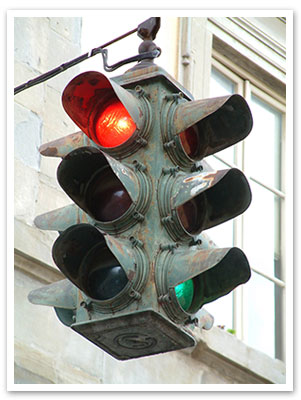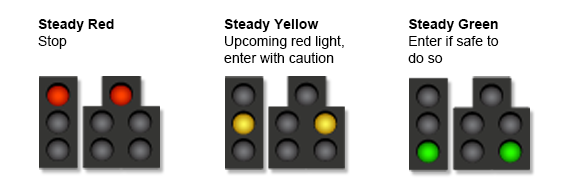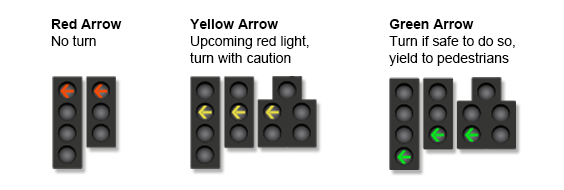Traffic Signals
Traffic signals direct traffic flow, help preserve safety, and make you a better driver. It is your job to know, recognize and obey these signals.

Signals have bright lights with colors that have distinct and consistent meanings. These lights are extremely helpful at night and during poor weather when it’s hard to see other signs and markings.
The lighted signals hang above and to the side of an intersection, making them easy for you to see no matter what your location is at an intersection.
It’s important to note that if a traffic signal is not working, you should stop and follow the procedures used at an intersection controlled by a four-way stop.
This means that you must come to a complete stop. If you come to a stop at the same time as another car, the car on the right should go first.
Traffic signals help keep you safe, and you must obey them at all times, except when an officer is directing traffic. If a traffic officer is telling you to do something other than what the signal indicates, obey the officer.
Steady Lights
Traffic signals are made up of three lights: red, yellow, and green. These lights may appear steady, flashing, or in arrows. All of these lights have different meanings.

Steady Red Light
Red, of course, means stop. When you see the steady red light, you must stop before entering the crosswalk or intersection. Right-hand turns from the right lane(s) are allowed unless you see a sign indicating they are prohibited.
You may also turn left if both streets are one way, unless a sign indicates that a left turn on red is prohibited.
Always yield to pedestrians and any other traffic that is lawfully using the intersection. Keep the crosswalk clear so that pedestrians have room to walk safely across the intersection.
To help position your vehicle, look for the stopping line, a bold white line indicating the exact location you should stop. Your front bumper should be just behind the stopping line.
Remain completely stopped until the light turns green, then check for any traffic that is blocking or about to enter the intersection and drive through with caution.
Steady Yellow Light
The steady yellow light means caution—the light is about to turn red! When you see a yellow light, prepare to stop before entering the nearest crosswalk at the intersection, as long as it’s safe to do so.
If you cannot stop safely, keep driving through the intersection but do so with caution.
Yellow lights are timed to give you plenty of time to stop as long as you are traveling the speed limit. You should be able to stop unless the light turns yellow right before you reach the intersection.
Steady Green Light
Green means go because you have the right-of-way. When the light is green, you may drive straight through the intersection, or turn, as long as the intersection is clear.
You may turn on a green light as long as the turn is not prohibited by some other sign or signal. It’s very important that you slow down and look carefully when you drive through an intersection. Watch for vehicles and pedestrians.
The most dangerous time to enter an intersection is immediately after the light has turned green. Other drivers may be trying to beat a red light.
Drivers run red lights frequently, especially during rush hour and at other busy times. Always scan an intersection for cars approaching at high speeds before you drive through, and proceed with caution.
Arrows

Arrow signals let you know when you have the right-of-way and can make a turn.
- Red Arrows: A red arrow means stop. You must yield the right-of-way at the intersection.
- Yellow Arrows: A yellow arrow informs you that your right-of-way to turn is about to end. If you are already in the intersection, turn with caution. Be aware that the light is about to turn red,
which means that oncoming traffic will be coming through the intersection shortly. Do not enter the intersection to make a turn when the signal is yellow.
- Green Arrows: A green arrow means that you have the right-of-way to turn. You may enter the intersection to make your turn, because oncoming traffic must yield the right-of-way to you.
However, keep an eye out for any vehicles already in the intersection as well as any pedestrians.
Flashing Red Lights
A flashing red light means you must stop completely before entering the crosswalk or intersection. Treat a flashing red light just like you would treat a stop sign.
You must come to a complete stop and observe proper right-of-way rules just as you would at a stop sign. If traffic on the intersecting road does not have to stop,
wait until you can drive through the intersection safely or have enough room to make a turn before proceeding into the intersection. If cross traffic must stop, then whoever gets to the intersection
first has the right-of-way after coming to a complete stop.
If two vehicles reach the intersection at the same time, the vehicle on the right has the right-of-way.
A flashing red arrow means that you may turn in the direction of the arrow, but you must come to a complete stop and yield the right-of-way first.
Flashing Yellow Light
A flashing yellow light means slow down and drive cautiously through the intersection.
A flashing yellow arrow indicates a phase where vehicles making a left turn may make their turn only if there's no oncoming traffic. The flashing yellow arrow may be displayed before and/or
after the protected green and solid yellow left turn arrows to improve traffic flow.
The flashing yellow arrow lets drivers know they must proceed with caution. It’s up to the driver to decide if there is enough of a gap in oncoming traffic for them to turn.
Traffic Signals Video
Take a look at the video below to learn more about traffic signals.
Take a Course to Learn More
If you enjoyed this article and are interested in learning more about driving-related topics, you should check out our courses on www.safe2drive.com.
We offer courses in a variety of topics including Defensive Driving and Driver Education. In addition to teaching you how to be a safe driver, our courses
can help you dismiss a ticket, get your driver license, or even get an insurance discount. We also have courses specifically tailored to mature drivers (i.e., drivers
age 55 and older) for insurance discounts.